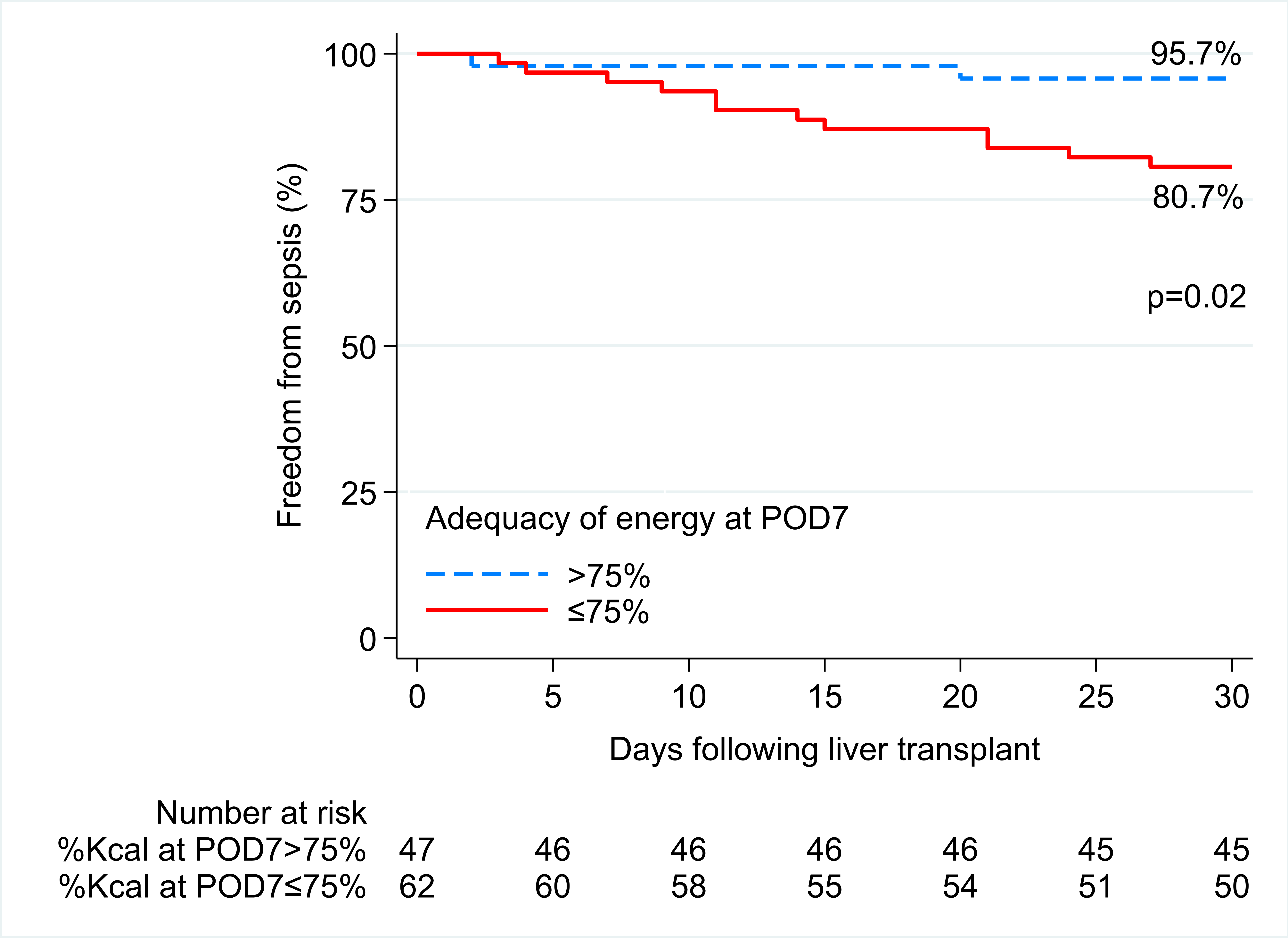Nutritional Inadequacy is an Independent Predictor of Sepsis Post-liver Transplantation
Houston Methodist Hospital, Houston, TX
Meeting: 2021 American Transplant Congress
Abstract number: 341
Keywords: Liver transplantation, Multivariate analysis, Risk factors
Topic: Clinical Science » Liver » Liver: Retransplantation and Other Complications
Session Information
Session Name: Post Liver Transplant Management and Complications
Session Type: Rapid Fire Oral Abstract
Date: Tuesday, June 8, 2021
Session Time: 4:30pm-5:30pm
 Presentation Time: 5:05pm-5:10pm
Presentation Time: 5:05pm-5:10pm
Location: Virtual
*Purpose: Malnutrition is universally prevalent in liver transplant (LT) recipients in the perioperative setting. Malnutrition contributes to post-LT complications, such as sepsis. We aimed to determine the association between perioperative nutritional inadequacy (NI) and sepsis 30-days post-LT.
*Methods: Patients who received a LT from Jan 2016-Dec 2017 were included in this single-site, retrospective review. Only patients with complete malnutrition data were analyzed. Patients were grouped according to nutrition inadequacy, with NI defined as meeting ≤75% of estimated energy needs (EEN) at post-operative day 7 (POD7). Those with NI were compared to patients meeting >75% EEN. Patient acuity was based on MELD, pre-LT dialysis, and ventilator dependence. Psoas muscle area (PMA) was obtained by CT/MRI scans at the L3 region within 6 months prior to LT and was a surrogate, objective marker of pre-LT malnutrition. Multivariable Cox regression analysis determined factors associated with sepsis within 30-days post-LT.
*Results: Out of 233 LT recipients, only 109 met inclusion criteria and were analyzed. NI occurred in 62 (57%) patients. Nutritional support, either enteral or parenteral, was required in 58 (48%) patients. NI occurred more frequently in patients who did not receive nutritional support (54% vs 32%, p=0.01). Patients with NI had more pre-LT malnutrition indicated by smaller median (IQR) PMA: 7.5 cm2 (5.8, 9.1) vs 8.3 cm2 (5.8, 9.6), p=0.27. The NI group had lower acuity compared to the >75% EEN group: lower MELD scores, 20 (11, 32) vs 35 (22, 40), p<0.001; less pre-LT dialysis, n=8 (13%) vs n=25 (53%), p<0.001; and less ventilator dependence, n=9 (15%) vs n=21 (46%), p<0.001, respectively. Patients with NI had a significantly higher incidence of sepsis, n=12 (19%) vs n=2 (4%), p=0.02 (Figure 1). After adjustment, patients with NI were 5.14 times more likely to develop sepsis within 30-days of LT compared to those with >75% EEN (HR: 5.14, CI: 1.08, 24.43; p=0.04; Table1).
*Conclusions: NI is an independent predictor of sepsis within 30 days of LT. Thus, perioperative nutritional status should be optimized for lower acuity patients who may not require nutritional support.
| Characteristics (N=109) | Adjusted HR (95% CI) | p-value |
| NI, nutritional inadequacy (energy at POD7) | ||
| >75% | (reference) | |
| ≤75% | 5.14 (1.08, 24.43) | 0.04 |
| MELD | 1.01 (0.96, 1.06) | 0.68 |
| Pre-transplant malnutrition (psoas muscle area) | 1.07 (0.87, 1.32) | 0.50 |
| Donor age (years) | 1.02 (0.98, 1.05) | 0.36 |
To cite this abstract in AMA style:
Fong JVNolte, Elshawwaf M, Moore LW, Graviss EA, Nguyen DT, Angell R, Uosef A, Hirase T, Mobley CM, Ghobrial R. Nutritional Inadequacy is an Independent Predictor of Sepsis Post-liver Transplantation [abstract]. Am J Transplant. 2021; 21 (suppl 3). https://atcmeetingabstracts.com/abstract/nutritional-inadequacy-is-an-independent-predictor-of-sepsis-post-liver-transplantation/. Accessed December 7, 2025.« Back to 2021 American Transplant Congress

